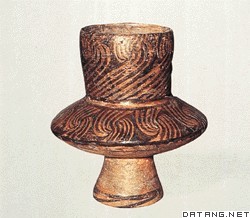1) Qujialing Culture-Shijiahe Culture


屈家岭文化-石家河文化
1.
Through a study of the literature, we believe that the documented area of Sanmiao was consistent with that of the Qujialing Culture-Shijiahe Culture.
通过对传世文献的考察,我们知道三苗的活动范围与屈家岭文化-石家河文化圈基本吻合。
2) Qujialing culture


屈家岭文化
1.
The Dawenkou and Qujialing Culture in Henan Province;


河南境内的大汶口文化和屈家岭文化
2.
Of them, remains of the Qujialing culture are the dominant.


巴东李家湾遗址中发现有周代、屈家岭文化和大溪文化三个不同时期的大批遗迹和丰富遗物。
3.
The Qingshuling site, a typical site of early Qujialing culture, yields remains including houses, ash pits and cooking stoves, and artifacts including ding tripods, pots, collared pots, basins, dou containers and weng containers.
青树岭遗址是一处典型的屈家岭文化早期遗存,主要遗迹有房子、灰坑和灶。
3) Shijiahe culture


石家河文化
1.
As major burial objects, pre-historical jade cicadas, mainly found from the bottom of urn coffin of the Shijiahe culture in the middle Yangtze River range, are related to funeral ceremony and the concept of soul in the Han dynast.
作为汉代主要葬玉之一的琀蝉,在史前时期主要发现于长江中游的石家河文化中,并且主要出土于瓮棺葬的底部,应该与某种丧葬仪式或灵魂观有关。
2.
After Chengbeixi Culture, Daxi Culture and Qujialing Culture, Shijiahe Culture arose as a new archaeological culture in the vast area of the middle reaches of the Yangtze River in the late Neolithic period.
石家河文化作为继城背溪文化、大溪文化和屈家岭文化之后,新石器时代末期在长江中游广阔的地域内兴起的一种新的考古学文化。
4) Post-Shijiahe culture


后石家河文化
5) shijiahe culture period


石家河文化时期
6) late Shijiahe culture


石家河文化晚期
1.
Within an area of 175 square meters,it yielded one residency remain and two ash pits of the late Shijiahe culture.
2004年进行了首次发掘,发掘面积175平方米,揭露了石家河文化晚期房址1处、灰坑2座,出土了陶鼎、碗、钵、杯、豆、盘、罐、瓮、缸、器盖、器座、纺轮、制陶拍、网坠、小鸟以及石斧、锛、镞等遗物。
补充资料:屈家岭文化
| 屈家岭文化 中国长江中游地区的新石器文化。因首先发现于湖北京山屈家岭遗址而得名。年代约距今 5000多年至4600年。分布地区以江汉平原为中心,西至三峡,东到武汉一带,北达豫西南,南抵洞庭湖区并局部深入到湘西沅水中下游。稻作农业是主要经济部门,在建筑遗迹的红烧土中发现有稻壳印痕,经鉴定为人工栽培的粳稻。居民还饲养家畜,兼事渔猎。生产工具有磨制的石斧、石锛、石镰、石镞和打制的凹腰石锄及彩陶纺轮等。陶器中有一种施彩纹具有晕染风格的薄胎彩陶器,精美而富有特色。已发现数处城址,其中湖南澧县城头山的圆形城址,直径约310米,外侧有护城河。当时居民的房屋大多是方形、长方形的地面建筑,有红烧土居住面,木骨泥墙或直接用粘土混合烧土渣垒成墙壁。既有单间的,也有套间或各开屋门的双间屋。多间式房屋的出现,显示出建筑技术的进步,同时可能反映了父系家族实行小家庭分居生活的情景。在建房过程中,有时还把整条猪、狗埋在房基下作为奠基牺牲。成年死者多采用土坑葬,儿童用瓮棺葬。安乡划城岗遗址的90多座墓分南北两区,居首并列的 3座墓各有随葬品数十件,包括朱绘陶器和朱绘卷云纹石钺等,墓主当是氏族中的上层人物。
|
说明:补充资料仅用于学习参考,请勿用于其它任何用途。
参考词条
